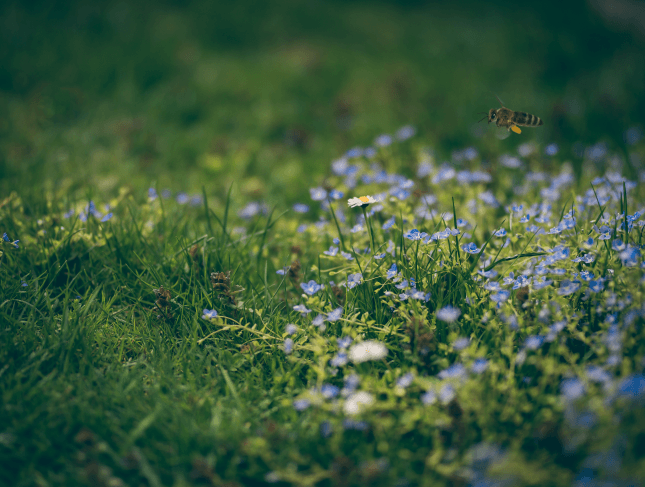Beedance
HISTORY OF THE BRAND
MNP introduced the Beedance brand in 2016. Due to its great garden characteristics, consumer popularity has grown rapidly. After the very successful introduction of Beedance, other breeders have also become very active with red Bidens hybrids. Currently, there are several brands on the market of different breeders but qualitatively, the Beedance is still top of the bill. Thus, Beedance’s comptetitors are less compact (wilder growth) and are less early and rich flowering.
‘Bij’zonder (Dutch for bee special).
WHAT’S IN A NAME
On a beautiful sunny morning in May 2015 at the MNP headquarters and testing facility in Leimuiderbrug, The Netherlands. Erwin Giezen, Head of Marketing and Communications of MNP walked his regular morning walk through the greenhouses. There he saw the new Bidens varieties. They were all covered in dancing bees and butterflies. He was thinking about John Travolta in ‘Saturday Night Fever’, and that’s how Beedance was born.
In 2017 the marketing department of MNP made some changes and improvements to the Beedance brand in order to incorporate modern standards of design and update its image. We have taken more appealing pictures of our plants, created a new logo, written new texts, developed new designs and, most importantly, we will soon be introducing our new and stunning Beedance Bidens varieties. The official Beedance branding is specially designed to tell you the full story of the Beedance collection, and inform you of the feelings it evokes and its special characteristics.
Bidens ferulifolia
BOTANICAL ROOTS
Bidens is a flowering plant in the Aster family (Asteraceae) and is named after the fruit it produces. During the summer months when walking outside you may find tiny seeds stuck to your socks or pants. Biden seeds have tiny barbs that allow the seeds to attach to fur or clothing as a means of seed dispersion.
Beedance is a Bidens ferulifolia and originates from North America (USA, Arizona and Mexico, Sonora). It’s also called ‘tick-seed’, and it’s a vigorous compact and dense low growing perennial plant that has fern-like leaves and lovely golden yellow, five petaled flowers which bloom from spring right through to autumn. It is quite bushy in its habit and works well in a mixed border or cascading over walls or pot edges. It has freely-branching stems with small narrow dark leaves and produces a profusion of golden yellow flowers that are held up over the foliage on wiry stems and are delicately fragrant. It’s a pretty and informal plant while being very hardy, drought, heat, and wind tolerant. It excels as a companion to larger plants in pots and planters and also goes very well in hanging baskets.
Ferulifolia means ‘with fern-like leave’. The leaves of the ferulifolia have little feathers around the edges.
Hybrids
A hybrid plant is the result of cross pollinating two different plant varieties and growing the seed the cross produces. The plant that grows from that seed is considered a hybrid. Like animals and humans, each crossing produce a lot of seeds which are all different.
Why Hybridize Plants?
We want to combine the qualities of the parents in the offspring to have the best plant as possible. Hybrids might be developed for disease resistance, size of plant, flower, or fruit, increased flowering, colour, taste or any reason a plant might be considered special. Most modern plants currently on sale are hybrids.
Getting to the desired result can take years of crossing. First time crosses are grown out the following year and the plants they produce are evaluated. If they meet expectations, the cross will be repeated and the seeds will be marketed. But it can take many years before a hybrid with the desired traits is even created. And when it is finally created it is tested again for a few years to be sure of a good and healthy specie.
Are Hybrid Plants Unnatural?
Most hybrid plants are intentional crosses, but hybridization can occur in nature. In fact, it happens quite often. Two nearby compatible plants can be cross pollinated by insects or the wind and the resulting seed simply falls on the soil and grows into a hybrid. Few of the flowers and vegetables we grow today are in their original wild form.
“We do the same as insects do in nature. The only difference is that we choose the 2 plants that will be crossed and the insects do it randomly” says Production Manager from MNP Juliette Einhorn.
Do Not Confuse Hybrids With GMO!
In nature, hybrids are hit or miss. Commercial hybrids come about after a great deal of work and many attempts are discarded if they do not produce the desired results. Whether the cross occurs by nature or man, do not confuse hybrids with genetically modified plants (GMO), which are created using techniques such as gene cloning. Hybrids are simply two plants that are cross-pollinated.






MNP / Suntory from the Netherlands is the company behind this successful brand. At this “house of brands” in Leimuiderbrug is where the magic happens: powerful brands are created after extensive tests and accurate selections of the highest quality genetics of indoor & outdoor plants coming from Suntory Flowers Ltd. (breeder) in Japan. MNP / Suntory gives custody for production of our products to carefully selected growers (propagators) in Europe, which we call our licensees; meanwhile, innovative stories are written. For this reason, we are the plant pioneers! “Pioneers & trendsetters in breeding, selecting, marketing and licensing of innovative and superior quality (bedding) plants.” To experience what characterises our unique products, you cannot miss a single one of “the plant pioneers” brands, click on the logos to discover them!















